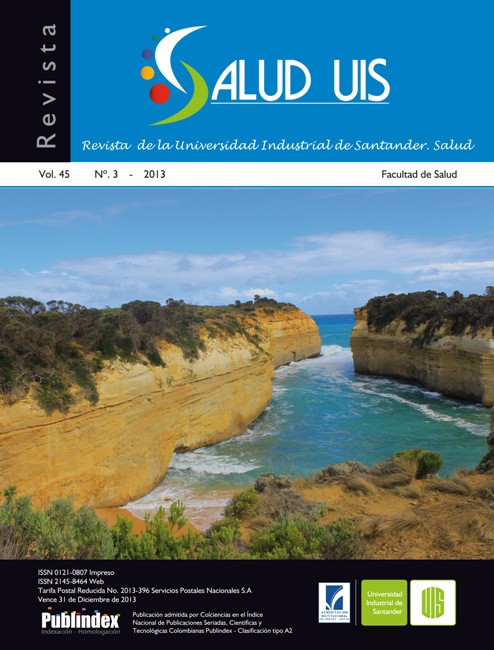Abstract
Background: Air pollution is one of the main risk factors for the development of respiratory diseases, however, there are few studies evaluating the levels of major pollutants in Latin American countries. Objective: To describe the levels of gases and particles in different sectors of Cartagena taking into account national standards for air quality in Colombia, and to explore the interactions of gases and particles in each sector. Methods: The methodology was divide in two phases: In phase I, for short periods (5 to 12 days) in 8 points of the city, the ozone, sulfur dioxide, carbon monoxide and small particles (<2.5 microns) concentrations were measured. In Phase II, a new measurement was performed in one sector for a long period time (12 months). Results: Gas concentrations were within the levels recommended by the national regulation. Particles levels were high, exceeding in four sectors the national regulation. Conclusion: The concentration of gases in Cartagena is during most of the time within the limits recommended by national standards. However, small particles concentrations remain high, especially in areas close to vehicular high traffic. Further studies that evaluate the impact of PM on respiratory diseases in people living near roads should be made.
References
Laumbach RJ, Kipen HM. Respiratory health effects of air pollution: Update on biomass smoke and traffic pollution. J Allergy Clin Immunol. 2012;129(1):3-11.
Moore K, Neugebauer R, Lurmann F, Hall J, Brajer V, Alcorn S, et al. Ambient ozone concentrations cause increased hospitalizations for asthma in children: an 18-year study in Southern California. Environ Health Perspect. 2008;116(8): 1063-70.
Delfino R. Epidemiologic evidence for asthma and exposure to air toxics: linkages between occupational, indoor, and community air pollution research. Environ Health Perspect. 2002;110 (Suppl 4) 573-89.
Vergara C, Sanchez J, Martinez B, Caraballo L. Epigenética en Asma. Iatreia. 2009;22(4):359-71.
Sanchez J. Physicochemical characteristics of gaseous and particulate air pollutants. Their impact on asthma. Iatreia. 2012;25(4):369-79.
Dennis R, Caraballo L, Garcia E, Caballero A, Aristizabal G, Cordoba H, et al. Asthma and other allergic conditions in Colombia: a study in 6 cities. Ann Allergy Asthma Immunol. 2004; 93(6): 568-574.
Caraballo L, Cadavid A, Mendoza J. Prevalence of asthma in a tropical city of Colombia. Ann Allergy. 1992;68(6):525-9.
Villeneuve PJ, Chen L, Rowe BH, Coates F. Outdoor air pollution and emergency department visits for asthma among children and adults: a case-crossover study in northern Alberta, Canada. Environ Health. 2007; 6: 40.
Heinrich J, Wichmann HE. Traffic related pollutants in Europe and their effect on allergic disease. Curr Opin Allergy Clin Immunol. 2004; 4(5):341-8.
Nordling E, Berglind N, Melén E, Emenius G, Hallberg J, Nyberg F, et al. Traffic-related air pollution and childhood respiratory symptoms, function and allergies. Epidemiology. 2008; 19(3): 401-418.
Gómez M. Red de Vigilancia de la Calidad de Aire en Antioquia. RedAire. 2005.
Gaitán M, Cancino J, Behrentz E. Análisis del estado de la calidad del aire en Bogotá. Rev Ingeniería. 2007: 26(11): 81-92.
Delfino RJ, Staimer N, Gillen D, Tjoa T, Sioutas C, Fung K, et al. Personal and ambient air pollution is associated with increased exhaled nitric oxide in children with asthma. Environ Health Perspect. 2006; 114(11): 1736-1743.
Wilhelm M, Meng YY, Rull RP, English P, Balmes J, Ritz B. Environmental public health tracking of childhood asthma using California health interview survey, traffic, and outdoor air pollution data. Environ Health Perspect. 2008; 116(9): 1254-60.
Calderón-Garcidueñas L, Mora-Tiscareño A, Fordham LA, Valencia-Salazar G, Chung CJ, Rodriguez-Alcaraz A, et al. Respiratory damage in children exposed to urban pollution. Pediatr Pulmonol. 2003; 36(2): 148-61.
Leung TF, Ko FW, Wong GW. Roles of pollution in the prevalence and exacerbations of allergic diseases in Asia. J Allergy Clin Immunol. 2012; 129(1): 42-47.
Babin SM, Burkom HS, Holtry RS, Tabernero NR, Stokes LD, Davies-Cole JO, et al. Pediatric patient asthma-related emergency department visits and admissions in Washington, DC, from 2001-2004, and associations with air quality, socio-economic status and age group. Environ Health. 2007; 6: 9.
Nestor R, Galvis B. Relación entre PM2.5 y PM10 en la ciudad de Bogotá. Rev Ingeneria. 2005; 22:7.
Acevedo N, Sánchez J, Zakzuk J, Bornacelly A, Quiróz C, Alvarez A, et al. Particular characteristics of allergic symptoms in tropical environments: follow up to 24 months in the FRAAT birth cohort study. BMC Pulm Med. 2012; 12: 13.

This work is licensed under a Creative Commons Attribution 4.0 International License.
Copyright (c) 2023 Jorge Sánchez, Juan Urrego, Josefina Zakzuk, Adriana Bornacelly, Ildefonso Castro, Luis Caraballo
